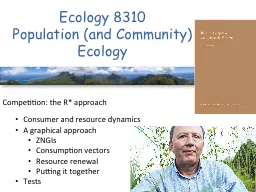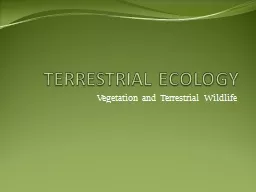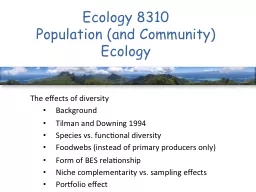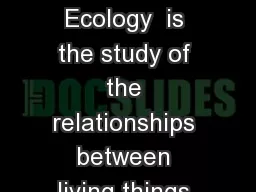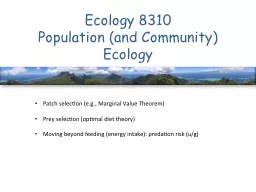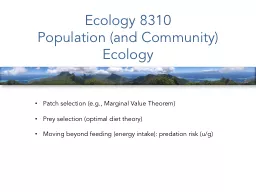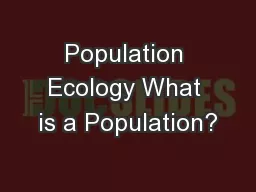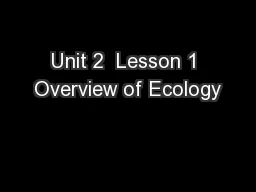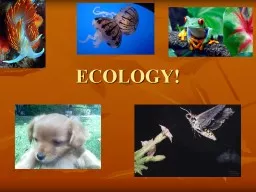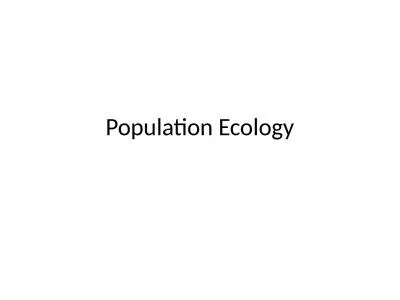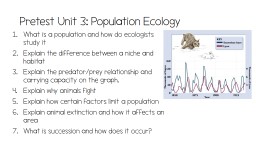PPT-Ecology 8310 Population (and Community) Ecology
Author : briana-ranney | Published Date : 2018-03-15
Predatorprey theory Basics LotkaVolterra Functional responses and risk Effect on phaseplanes Dynamics Paradox of enrichment Predator interference and ratio dependence
Presentation Embed Code
Download Presentation
Download Presentation The PPT/PDF document "Ecology 8310 Population (and Community) ..." is the property of its rightful owner. Permission is granted to download and print the materials on this website for personal, non-commercial use only, and to display it on your personal computer provided you do not modify the materials and that you retain all copyright notices contained in the materials. By downloading content from our website, you accept the terms of this agreement.
Ecology 8310 Population (and Community) Ecology: Transcript
Predatorprey theory Basics LotkaVolterra Functional responses and risk Effect on phaseplanes Dynamics Paradox of enrichment Predator interference and ratio dependence How do predators respond to prey. and . dis. -assembly. Topics for today. Assembly Rules: concepts, conflicts. Early work: plant succession from the 1910’s (and relevance in the 2010’s). Diamond’s . biogeographical. work in the 1970’s. Gerry Quinn. Deakin University. Data sets in community ecology. Multivariate abundance data. Sampling or experimental units. p. lots, cores, panels, quadrats ……. u. sually in hierarchical spatial or temporal structure. Population (and Community) Ecology. Competition: the R* approach. Consumer and resource dynamics. A graphical approach. ZNGIs. Consumption vectors. Resource renewal. Putting it together. Tests. The basics:. Vegetation and Terrestrial Wildlife. Vegetation. Plant Communities. Disturbance. Unique Communities. Wildlife. Amphibians and Reptiles. Birds. Mammals. Terrestrial Ecology: Vegetation. Goals of vegetation sampling on ODOT projects. Population (and Community) Ecology. The effects of diversity. Background. Tilman. and Downing 1994. Species vs. functional diversity. Foodwebs. (instead of primary producers only). Form of BES relationship. In short, . ecology . is the scientific study of the . interactions of organisms with their environment. .. All organisms . interact. with other organisms in their surroundings and with the nonliving portion of their environment. . Patch selection (e.g., Marginal Value Theorem). Prey selection (optimal diet theory). Moving beyond feeding (energy intake): predation risk. . (u/g). Patch selection. :. Consider a forager moving among many patches during a foraging bout (rodent among seed caches, pollinator among flowers, etc.). Patch selection (e.g., Marginal Value Theorem). Prey selection (optimal diet theory). Moving beyond feeding (energy intake): predation risk. . (u/g). Patch selection. :. Consider a forager moving among many patches during a foraging bout (rodent among seed caches, pollinator among flowers, etc.). An interbreeding group of the . same species. living in the same general area. may be distinguished by natural or . . arbitrary boundaries. Population Density vs Dispersion. the number of individuals per unit area or volume. and. Levels Of Organization in . Biology and Ecology. Springfield Central High School. Questions to Answer. Daily Problem Set Unit 2- #1. 1. . Explain what ecology is. . 2. . In the relationship between the lynx and the hare, what factors, biotic and . HW #1. Age-structured populations. Stage-structure populations . Life cycle diagrams. Projection matrices. Context: Sea . Turtle . Conservation. (But first … background). Population. Structure. :. I. Biotic and . Abiotic. Factors. A. Biotic Factors-- all living things that inhabit an environment. 1. relationships with organisms of the same or different species. . B. . Abiotic. Factors: The nonliving environment. SW: discuss with their groups how estimating a population could be used in a real world situation.. Population Ecology. Measuring a population. Growth Curves. Biotic Potential vs. Environmental. Resistance. What is a population and how do ecologists study it. Explain . the difference between a niche and . habitat. Explain the predator/prey . relationship and carrying . capacity on the graph. . Explain why animals fight.
Download Document
Here is the link to download the presentation.
"Ecology 8310 Population (and Community) Ecology"The content belongs to its owner. You may download and print it for personal use, without modification, and keep all copyright notices. By downloading, you agree to these terms.
Related Documents



